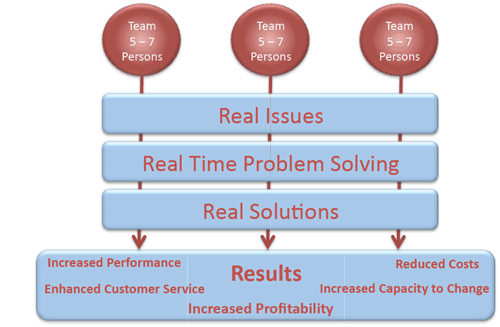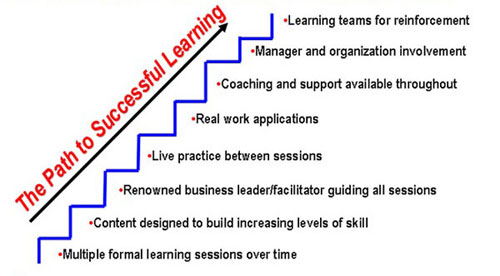WSA's Unique Value |
||
WSA's Unique Value
|
Structured CoachingA Training Methodology That Produces
|
|
WSA's 25 plus years of experience focused on getting tangible results from its development efforts has led to a set of disciplines that deliver positive improvements in bottom line organizational performance. |
||
Details Below |
||
Pathways for Organizational Change
As organizations address change, they face a number of challenges. Part of the challenge is understanding the external environment and the forces that create the need for internal change. Part of the challenge is defining the desired end result, and building the plan to help achieve it. However, the greatest challenge is in the implementation itself, and in making the new organizational state the ongoing normal way of conducting business.
Change does not happen by wishing it or demanding it. It only occurs when a well-defined process is established, and a pathway is created to help the change process unfold. These pathways must be created at organizational, cross-functional, functional, team and individual levels.
There are several methods that can be used to provide this pathway. One common method employed is simply mandating the desired change and attempting to “brute force” it through the organization. The typical consequence of this method is a short term effect while the pressure is being applied. When the pressure is released, however, the organizational “immune system” immediately takes over and the organization reverts to its prior state.
Another common method is the use of outside experts or consultants who spend a significant period of time on-site to install the change, serving as both technical experts and implementation consultants. This approach adds competence and support. Unfortunately, it also creates a dependent relationship on the consultants, and creates a subsequent vacuum when they depart. The vacuum is filled with the “great sucking sound” of the organization returning to the same state prior to the arrival of the consultants.
Training is another common vehicle for supporting organizational change. As an “event-driven” approach to change, training has some very positive features. It provides individuals with the knowledge and skill needed for the change. It creates an environment where it is acceptable to ask questions, to learn, and to challenge. When well designed, it provides the opportunity for practice in a risk-free environment.
There are many benefits. However, the primary disadvantage is that while the training is occurring, the existing organizational environment remains the same. When individuals return “home” after training, they are confronted with the same barriers, problems, and issues that existed before they left. Their lives are immediately consumed with all of the tasks and problems that were consuming them before they left. When others in the environment do not receive the same skill or understanding, they cannot help the newly trained individuals implement what they have learned. In fact, this lack of understanding may cause even the most well-intended to serve as unwitting resistors to new ideas or concepts.
Action Learning: The Structured Coaching Process
The solution is through some form of action learning: learning applied in context. Learning that occurs by doing. Learning that solves real time problems. Learning that incorporates new knowledge and skill “just-in-time” in the problem-solving process. And learning that includes those individuals acting as change agents in the real time environment so that understanding and commitment can be developed by many through participation. Action Learning is considered to be “double loop learning”; a term coined by Chris Argyris to mean that the learning is not merely superficial and easily forgotten, but that it changes the knowledge base, through action, of the individual.
The model developed at Work Systems to provide this action learning environment is called the Structured Coaching Process. Structured Coaching is a process in which up to three real time business issues that organization needs to address are identified and a real time team is formed for each issue. The team is assigned a leader, a facilitator and an organizational sponsor. This team is then given a period of time –related to the scope of the problem – to use the new models and skills to address and solve the assigned problem.
To guide the process, a Work Systems consultant is assigned as the “external coach”, and takes the team(s) together through a structured problem-solving process. The process must include a defined methodology which represents a large part of the new learning to be applied. When applied to Total Quality or Continuous Improvement, the Work Systems 10-step problem solving methodology is applied. When applied to re-engineering, the Work Systems re-engineering model is utilized.
The consultant meets with the three teams together (typically about 21 people representing 7 per team) for two days. During these first two days, the team receives teambuilding training and an overview of the model they are going to use to solve their problem. The teambuilding is real time in nature, since these are the actual people who will be working together to solve the problem. The team is also provided with detailed instruction in the first one or two steps of the process. Following this intense training, they begin the actual work of applying this process to their team problem.
At the end of this initial session, the teams are assigned a real time work assignment. The assignment is the completion of the application of these first few steps of the process, typically to be conducted over the next thirty days. In addition, this application usually involves getting data, input or feedback from other individuals in the organization and involving others in the process. The assignment typically request that each team meet approximately once per week as a team for several hours. It may also require some individual work on the part of team members. (This work does not replace the actual work assignments of these individuals. It may require some adjustments of their workloads but should not demand major modifications of work assignments.) The teams are required to return on a pre-established meeting to share their results with each other.
During the intervening period while the team is working, the Work Systems consultant is available for ongoing coaching and support. This support is provided through telephone “hot line” service and the review and feedback of materials through email and telephonic discussions. If required, supplemental sessions may be established with individual teams or team leaders or facilitators.
At the next meeting – which is one day in length – each team presents its results to the other two teams for input and feedback. This creates another opportunity for both coaching and action learning. Teams provide peer feedback which is both reinforced and supplemented by the Work Systems consultant. The feedback is live and applied to the real problem. The teams learn how to give and receive positive, constructive criticism. Peer pressure is subtly being applied through the requirement of a group presentation. This typically has the effect of ensuring that all teams invest the necessary energy to create a quality result.
These team presentations and peer reviews with Work Systems coaching typically consume the morning of this follow up session. The Work Systems consultant provides just-in-time” training for the next steps in the problem solving process. The teams then have time during the remainder of the day to being applying these steps, facilitated by the Work Systems consultant. Teams then leave with a defined assignment for the next thirty days or until the next meeting.
This process continues through a number of sessions (typically five in a series) until the teams have completed the structured coaching process and developed real time recommendations for application in the organization.
While this structured coaching process is being implemented, the sponsor provides ongoing external support. Although not an official member of the team, the sponsor is a member of the senior management assigned to provide for the care and nurturing of the team. This may include ensuring that resources are available as required, removing organizational barriers; dealing with internal political issues; and providing ongoing visibility of the effort to the entire senior management team.
The organization also needs to create a governance infrastructure to support the approval process of team recommendations. This infrastructure includes the decision making group; decision making process; criteria for endorsement; and a pathway to ensure implementation of the endorsed recommendations.
Characteristics of Structured Coaching
The Structured Coaching process includes the following characteristics:
• A well-defined technical process that takes a group through the steps required to analyze a problem; modify a process; re-engineer an organization; or use other appropriate technology to address the issue assigned to the team.
• Designed to guide a team – rather than several individuals working independently – to build commitment and generate the synergy that comes from the best thinking of all those involved in the critical stages of the process.
• An intervention by the consulting organization that provides key skill building and support along with ongoing reinforcement and availability to answer questions and provide guidance without “taking over”.
• A combination of coaching, feedback, training and technical, organizational and interpersonal support to help the team achieve success.
• A process that has a series of relatively intense sessions, with sufficient time between these sessions for “real work” to be done but not so long that the team can go very far astray without short term course corrections.
• An intervention that integrates the team effort with senior management sponsorship to ensure organizational communications and support for the analysis, the solution and the subsequent implementation of the solution.
• A process that generates both organizational and peer learning through a defined team problem solving methodology.Results Created by the Structured Coaching Process
When applied as described, the result of the structured coaching process includes the following.
• Up to three real time organizational problems have been identified and addressed. (These are typically cross functional issues that have been plaguing the organization for some time.
• A group of individuals (usually 15 to 21) have been trained in a defined problem solving methodology and can now lead and guide others in using this process to address additional problems and issues.
• The organization has had broad involvement in the process, and a deeper commitment has been made both to the proposed solutions and to their implementation.
• The senior management group has established (or re-affirmed) an infrastructure and process for examining and endorsing several broader organizational issues.
• Three “success stories” have been created that can now be used as the springboard for ongoing and continuous improvement.
• Organizational learning has occurred through a team process which makes the learning transferable to other situations.Structured Coaching is a unique approach to action learning. It provides a tool and a process for developing and applying new skills and technologies in the context of solving real time business problems and guiding organizational change.
Building Blocks of a
Structured Coaching Training Program


